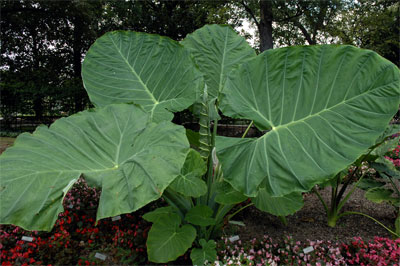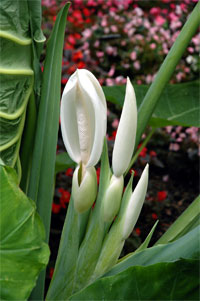Plant of the Month – April, 2008

Leaves of Colocasia gigantea dwarf adjacent bedding plants.
Photo courtesy of Jimmy Turner.
Colocasia gigantea: Giant Elephant Ear

The blossoms are large, white, sculptural and scented.
Photo courtesy of Jimmy Turner.
AT A GLANCE
Latin name: Colocasia gigantea
Common name: giant elephant ear
Origin: Thailand
Plant type: tropical
Flowers: 6”-long, white clusters of calla-lily-like flowers
Foliage: Huge elephant ears
Mature height: 9’
Hardiness: Zone 8b south
Soil: well drained
Exposure: afternoon shade
Water usage: high
Sources: mail order/ retail
Everything is bigger in Texas, or so I’ve always heard! Well, when it comes to elephant ears, Thailand has us whupped, hands down. Luckily, their elephant ear, Colocasia gigantea, is quite happy in our gardens here in Texas. This elephant ear will easily reach nine feet tall in one season, and the powdery grey leaves will be at least five feet long and four feet wide by the end of summer.
I recommend that you either buy these via mail order (do a Google search) or ask your local retailer to order them for you. The photos you see here are of mine at the Dallas Arboretum; plants were started in four-inch pots and grew to massive nine-feet-tall giants in one season. This is not a “waterwise” plant. It wants massive amounts of water and fertilizer and is happiest when the outdoor temperatures and humidity are in the 90-plus range.
In its native country, this plant is used for pig food, but in my garden, I’d use it in containers around the pool, as a focal point in an east-facing bed or in a large grouping in a courtyard, underplanted with caladiums and impatiens. If you are into the tropical look, then this plant is a must-have. I recommend planting it where it will receive filtered light or morning sun; I find it almost impossible to keep watered if it’s planted in full sun. If you live along the coast, where the humidity is higher, then you’ll have more luck in full sun.
Now the burning question is, "What do I do with it during the winter?" Well, if you live south of Zone 8b, you can leave it outside. North of that, you might succeed in overwintering it in a mild winter, but I’d dig it up, cut off the leaves, plant it in a five- or ten-gallon pot and stick it in the garage for the winter. This isn’t a cheap plant, and after showing your neighbors up the first year, I’m sure you won’t miss the chance to do it again the next!
This plant had one surprise for me. It has beautiful flowers — clusters of large, white calla-lily-like flowers that are mildly scented. If the big leaves don’t wow you enough, then the flowers will definitely do it.
This is the ultimate in what I call “neighbor-beater plants.” We all garden to relax, commune with nature, and enjoy the beauty. But you have to admit that every so often you really need a plant to make all your neighbors green with envy! If a nine-foot-tall elephant ear with leaves big enough to use for a twin bedspread can’t do it, then I don’t know what can.
About the author: Jimmy Turner is the director of horticulture research at the Dallas Arboretum. Visit www.dallasplanttrials.org for information on his trials. For more plant profiles by Jimmy, subscribe to Neil Sperry’s GARDENS Magazine.

